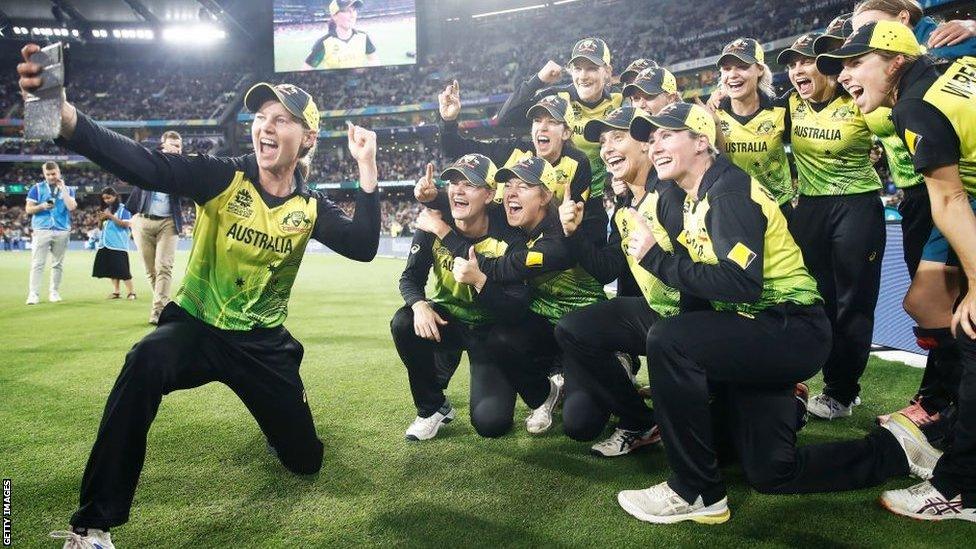Cricket World Cup: The Australia juggernaut blocking England's World Cup path
- Published

Australia won the T20 World Cup in 2020 with victory over India in Melbourne
Women's Cricket World Cup final: England v Australia |
|---|
Venue: Hagley Oval, Christchurch Date: Sunday, 3 April Time: 02:00 BST |
Coverage: Ball-by-ball Test Match Special commentary on BBC Radio 5 live; Live text commentary & highlights on BBC Sport website, plus desktop, tablets, mobiles and app. |
What exactly is a 'juggernaut'?
The dictionary definition is "a massive inexorable force, campaign, movement, or object that crushes whatever is in its path".
An alternative definition could be 'the Australia women's cricket team', who can lay claim to being the best sports team in the world.
Within living memory of men's cricket, the West Indies team from the mid-1970s to the mid-1990s - who were unbeaten in Test series for 15 years and won the first two World Cups - and the Australian team from the mid-1990s to 2007 - with two record sequences of 16 consecutive Test wins and three consecutive World Cup titles - undoubtedly meet the definition of juggernauts.
A team which have won 37 out of 38 one-day internationals must qualify as well.
This is what Australia's women, led by Meg Lanning, have achieved from the beginning of 2018 to the semi-final of the 2022 World Cup, including a record 26 consecutive victories. England have their work cut out in Sunday's final.
Here are the longest sequences of consecutive women's ODI wins:
Wins | Team | Start | End |
26 | Australia | 12 Mar 2018 | 24 Sep 2021 |
17 | Australia | 12 Dec 1997 | 7 Feb 1999 |
16 | Australia | 25 Feb 1999 | 18 Dec 2000 |
16 | India | 7 Feb 2016 | 15 May 2017 |
13 | England | 19 Jul 1989 | 20 Jul 1991 |
In men's ODIs the leaders are:
Wins | Team | Start | End |
21 | Australia | 11 Jan 2003 | 24 May 2003 |
12 | South Africa | 13 Feb 2005 | 30 Oct 2005 |
12 | Pakistan | 18 Nov 2007 | 8 Jun 2008 |
12 | South Africa | 25 Sep 2016 | 19 Feb 2017 |
11 | West Indies | 4 Jun 1984 | 2 Feb 1985 |
11 | Australia | 14 Mar 2007 | 28 Apr 2007 |
In all men's List A one-day matches (a much bigger sample of more than 28,000 matches) the most consecutive wins by any team is Australia's 21 (as above), although they were equalled by Tamil Nadu between 2009 and 2011.
So Australia women's 26 comfortably beats anything a men's team have done.
Not surprisingly, Australia are well ahead of the pack in women's ODI results since the start of 2018.

These figures do not include no-results. While South Africa have won an impressive 69% of their matches, this pales into insignificance compared to Australia's 97%.
What has driven this run of success for Australia?
Over that period Australia have scored an average 45.07 runs per wicket and 5.49 runs per over while conceding 20.82 runs per wicket and 4.12 runs per over.
Extrapolate those numbers to 50 overs: on average they score 274 for 6.1 and concede 206 for 9.9, which is a comfortable 68-run margin and a high likelihood of bowling their opponents out.

Australia dominate the numbers for batting and bowling averages in ODI cricket
Australia are the best in both categories, but it is with the bat where they really stand out.
The next best in the bowling metrics are Bangladesh, but Bangladesh are last in the batting metrics, suggesting they played most of their matches in lower-scoring environments.
Perhaps a better comparison, therefore, is with England, who are next in the rankings. Australia are 12% better in bowling average and 1.7% better in economy rate than England.
On the other hand, Australia's batting is really 'juggernauty': they are 48% better in runs per wicket than any other team (India are second with 30.54) and 7.9% better on run-rate than next best New Zealand's 5.06.
Their dominance in the batting department is well illustrated in their consecutive wins over India and South Africa in the round-robin phase of this World Cup.
In both matches their opponents batted first and made more than 270, a total that prior to 2022 had been successfully chased only four times in women's ODIs.
Given this history, both India and South Africa would have fancied their chances of stopping the juggernaut. But Australia inexorably chased both targets down.
Watch the best catches at the 2022 Women's World Cup
Drilling down to individual level, there are five Australian batters who average more than 40 since 2018, with a minimum of 500 runs.
Beth Mooney, with 1,122 runs at 62.33, leads the way, followed by Meg Lanning (1,454 at 51.92), Alyssa Healy (1,829 at 49.43), Ellyse Perry (939 at 49.42) and Rachael Haynes (1,529 at 44.97).
The top four in that list are all in the top 10 of overall averages in that time (Haynes is 11th).
By comparison, of bowlers with 20 or more wickets, two Australians are in the top 10 of the averages: Jess Jonassen is second with 58 wickets at 14.34, just behind Pakistan's Sana Mir, whose 34 wickets cost 14.29 apiece. Australian Megan Schutt makes 10th spot with 48 wickets at 21.83.
All of which suggests that Australia's gameplan for ODI success is to score big runs and bowl a better than all the other teams.
When will the juggernaut stop crushing whatever is in its path...?
England happy to be underdogs in final, says Shrubsole

Britain's rape crisis: Police investigate why only one per cent of reported rapes results in a conviction
AI is replacing recruiters: Computer programmes may be preventing you from securing your dream job
